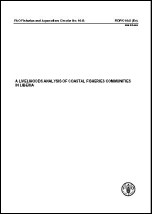 |
FAO Fisheries and Aquaculture Circular No. 1043
A livelihoods analysis of coastal fisheries communities in Liberia.
by
Moustapha Kebe
FAO Livelihoods Expert
Dakar, Senegal
Petter Jern
Socio-Economist FAO FishCode STF Projecte
Rome, Italy
Raphael Collins
Ministry of Agriculture Bureau of National Fisheries
Monrovia, Liberia
Wisseh Kay
Ministry of Agriculture Bureau of National Fisheries
Monrovia, Liberia
Eric Kekula
Ministry of Agriculture Bureau of National Fisheries
Monrovia, Liberia
|
FOOD AND AGRICULTURE ORGANIZATION OF THE UNITED NATIONS
Rome 2009
|
CONTENTS
The designations employed and the presentation of material in this information product do
not imply the expression of any opinion whatsoever on the part of the Food and Agriculture
Organization of the United Nations (FAO) concerning the legal or development status of any
country, territory, city or area or of its authorities, or concerning the delimitation of its frontiers
or boundaries. The mention of specific companies or products of manufacturers, whether or
not these have been patented, does not imply that these have been endorsed or recommended
by FAO in preference to others of a similar nature that are not mentioned.
The views expressed in this information product are those of the author(s) and do not
necessarily reflect the views of FAO.
|
ISBN 978-92-5-106301-9
All rights reserved. Reproduction and dissemination of material in this information product
for educational or other non-commercial purposes are authorized without any prior written
permission from the copyright holders provided the source is fully acknowledged. Reproduction
of material in this information product for resale or other commercial purposes is prohibited
without written permission of the copyright holders. Applications for such permission should be
addressed to: Chief, Electronic Publishing Policy and Support Branch, Communication Division,
FAO, Viale delle Terme di Caracalla, 00153 Rome, Italy or by e-mail to: [email protected]
© FAO 2009
|
PREPARATION OF THIS DOCUMENT
This FAO Fisheries and Aquaculture Circular is based on a study carried out as a collaboration
between the Fisheries and Aquaculture Department at the Food and Agriculture Organization of the
United Nations (FAO) and the Bureau of National Fisheries (BNF), Ministry of Agriculture,
Monrovia, Liberia.
The main aim of the study was to get relevant information on the livelihoods of the marine fisheries
communities in Liberia to support the process of decision-making in the sector.
This circular was prepared by Moustapha Kebe (FAO Livelihoods expert), Petter Jern (Socio-
Economist, FAO FishCode STF Project), Raphael Collins, Wisseh Kay and Eric Kekula (Ministry of
Agriculture - Bureau of National Fisheries), Liberia.
Technical support for the study has been provided by the FAO Fisheries and Aquaculture Department
and financial support has been provided through the Swedish International Development Cooperation
Agency (FAO FishCode STF Project) and the Department for International Development (FAO
Sustainable Fisheries Livelihood Programme).
|
Kebe, M.; Jern, P.; Collins, R.; Kay, W.; Kekula, E.
A livelihoods analysis of coastal fisheries communities in Liberia.
FAO Fisheries and Aquaculture Circular. No. 1043. Rome,
FAO. 2009. 20p.
ABSTRACT
As part of the Fisheries Action Plan, a livelihood study was conducted using sustainable
livelihoods approach (SLA) in Liberian fishing communities with the objective of getting
relevant information on the livelihoods of the fisheries communities to support the process of
decision-making in the sector.
FAO's main work was in the preparatory stage; the training and design of the livelihood survey.
The field team consisted of Bureau of National Fisheries (BNF) staff and enumerators hired by
BNF which was trained in SLA and participatory rapid appraisal (PRA). This holistic analysis
of the livelihoods of the fisheries communities along the coast of Liberia highlighted the
following:
- The main artisanal fisher group are the Kru. The migrant fishermens (Fanti and Popo)
presence contributes to the development of fishing gear and technical knowledge.
Overall, the national Kru are smaller in scale.
- The vulnerability to poverty in fishing communities is considered to be high. This is
caused by seasonality and absence of safety at sea; conflicts between industrial fisheries
and between migrant and local fishermen; high prices of inputs and commodities and
high prevalence of diseases are the cause of vulnerability of the fisherfolks.
- Weak livelihood capital assets and an unfavourable political and institutional
environment contribute to exposure to poverty.
Two main entry points were identified for future interventions aimed at assisting fisheries
communities. The improvement of human and social capital as well as the political and
institutional environment could help to making physical, financial and natural capital more
efficient. Better representation of communities leading to an active role in the preparation and
implementation of policies would also reduce vulnerability through a better choice of strategies,
permanent achievements, diversified and strong partnerships.
From a fishing perspective, access to fishing materials and improvement of surveillance are
main concerns from a perception. Better housing facilities and access to microcredit are
mentioned as priority actions from a socio-economic perception.
Considering the fisheries sectors large potential to contribute to socio-economic development,
political and institutional environment should be improved.
|
Preparation of this document
Abstract
Acknowledgements
Acronyms and abbreviations
1. INTRODUCTION
2. METHODOLOGY
3. ASSESSMENT OF THE FISHERIES COMMUNITIES' LIVELIHOODS
4. IMPLICATIONS IN TERMS OF POLICY
5. REFERENCES
ANNEXES
How to Order
